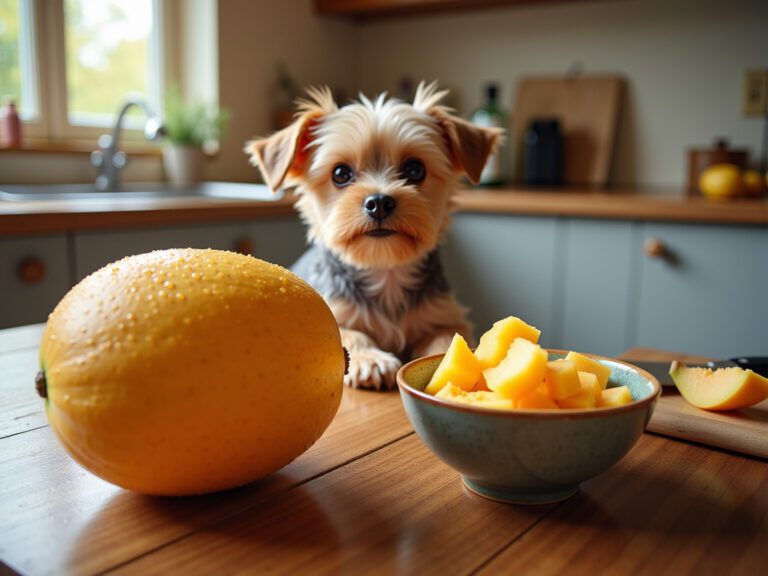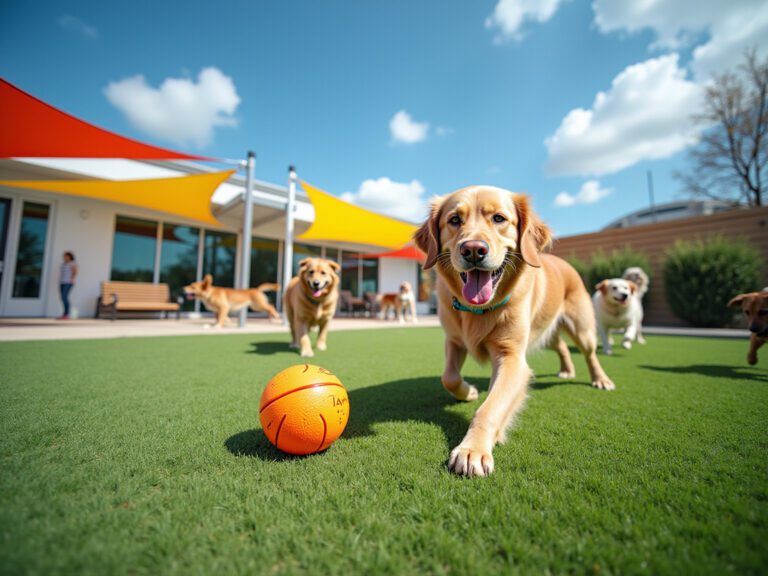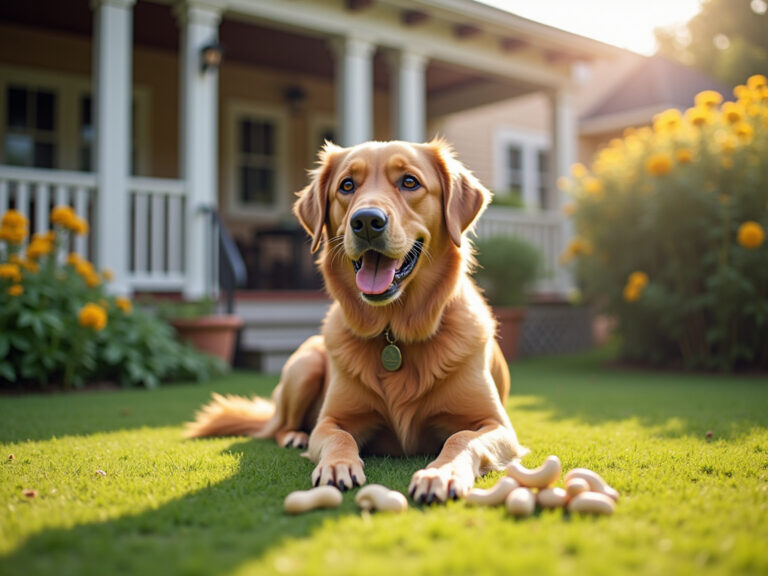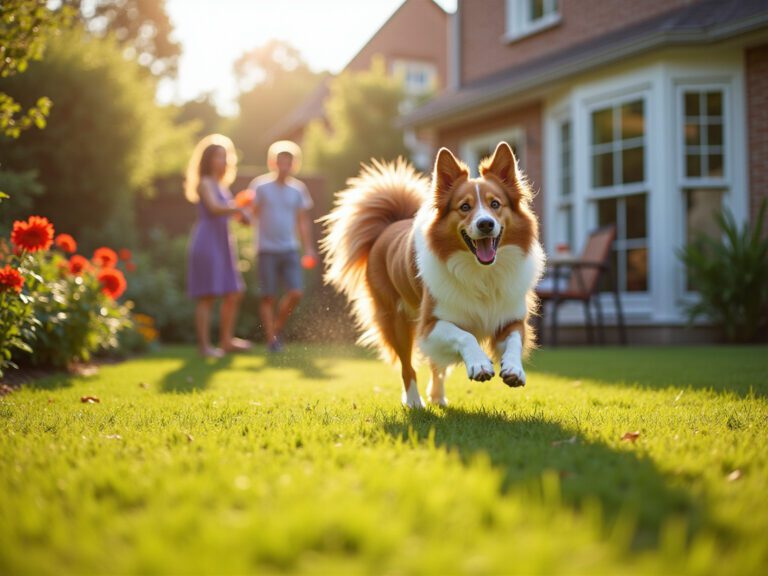Can Dogs Have Lettuce? Steps for Safe Introduction
Overview
As a loving pet owner, you may be curious about healthy snacks for your furry family members. Did you know that dogs can enjoy lettuce as a low-calorie, hydrating treat? This crunchy green offers beneficial vitamins, making it a delightful addition to their diet. However, it’s important to introduce it carefully to avoid any digestive issues.
At Adventure Den, we understand that monitoring your dog’s reaction is crucial. Gradually incorporating lettuce into their meals allows you to observe how they respond. This nurturing approach not only highlights the benefits of lettuce but also addresses any potential risks associated with its consumption. Remember, each dog is unique, and their health and happiness are our top priorities.
So, why not give it a try? Your beloved companion might just enjoy this refreshing snack, and you can feel confident knowing you’re providing them with something nutritious. Let’s create a caring environment together, ensuring that every bite is a step towards their well-being.
Introduction
As you explore ways to diversify your furry family members’ diets, the question of whether dogs can enjoy lettuce often arises. This leafy green offers a low-calorie, hydrating option that can enhance your dog’s nutritional intake when introduced properly. However, it’s important to understand the potential benefits and risks associated with this seemingly simple addition.
- Can your beloved dogs truly enjoy lettuce without adverse effects?
- What steps can you take to ensure a safe introduction?
Let’s delve into this together, ensuring a nurturing environment for your pets.
Understand Your Dog’s Nutritional Needs
Dogs thrive on a balanced diet that encompasses proteins, fats, carbohydrates, vitamins, and minerals. As you consider introducing lettuce into your furry family member’s diet, let’s explore a few important aspects:
- Protein: This is essential for growth and maintenance. It’s vital to ensure that your dog’s primary meals are rich in high-quality protein sources that support their needs.
- Fats: These are necessary for energy and maintaining healthy skin. Look for wholesome fat sources in their regular meals to keep them vibrant and energetic.
- Carbohydrates: They provide energy and assist with digestion. Lettuce can be a delightful low-calorie carbohydrate option, so it’s worth asking, can dogs have lettuce to add variety to their diet?
- Vitamins and Minerals: These are crucial for overall well-being. While lettuce contains some beneficial vitamins, like A and K, it raises the question of whether can dogs have lettuce, as it should complement, not replace, other nutrient-dense foods.
It’s always a good idea to consult with your veterinarian to determine your dog’s specific nutritional needs based on their age, weight, activity level, and health status. This way, you can ensure that you are providing the best care possible for your beloved companion.

Explore the Benefits and Risks of Lettuce for Dogs
When introduced properly, you may wonder if can dogs have lettuce as a healthy addition to your furry family member’s diet. Here are some benefits and risks to consider:
Benefits:
- Low-Calorie Snack: Lettuce is low in calories, making it an excellent treat for overweight dogs. It helps them feel full without adding excess calories. One cup of shredded raw romaine lettuce contains approximately 7.99 kcal.
- Hydration: With over 90% water content, it aids in keeping your dog hydrated, especially during warmer months.
- Fiber: This leafy green is a good source of dietary fiber, offering approximately 0.99 g per cup. This can aid digestion and help control bowel movements, promoting gastrointestinal well-being.
- Vitamins: Lettuce contains essential vitamins A and K, contributing to skin condition and bone strength, which are vital for your dog’s overall well-being. Dr. Athena Gaffud points out that this leafy green is packed with essential nutrients that can contribute to a stronger immune system and improved overall health.
Risks:
- Digestive Upset: Excessive consumption of lettuce can lead to diarrhea or gas, particularly if your dog is not accustomed to high-fiber foods. It’s crucial to introduce it gradually to avoid discomfort, especially when asking, can dogs have lettuce?.
- Choking Hazard: Large pieces of greens can pose a choking risk, especially for smaller dogs. Always chop or tear lettuce into small, manageable pieces before serving to ensure safety.
- Moderation is Key: New foods should always be introduced in moderation to prevent overwhelming your dog’s digestive system. A general guideline suggests starting with small amounts, such as 1/4 cup for extra-small canines and up to 2 cups for larger breeds.
- Avoid Harmful Additives: Ensure that the greens are served plain, as common salad ingredients like onions and dressings can be toxic to dogs. Always wash greens thoroughly to remove any pesticides or harmful bacteria before offering them to your pet.
By keeping these considerations in mind, you can create a nurturing environment for your beloved pet, ensuring their health and happiness.
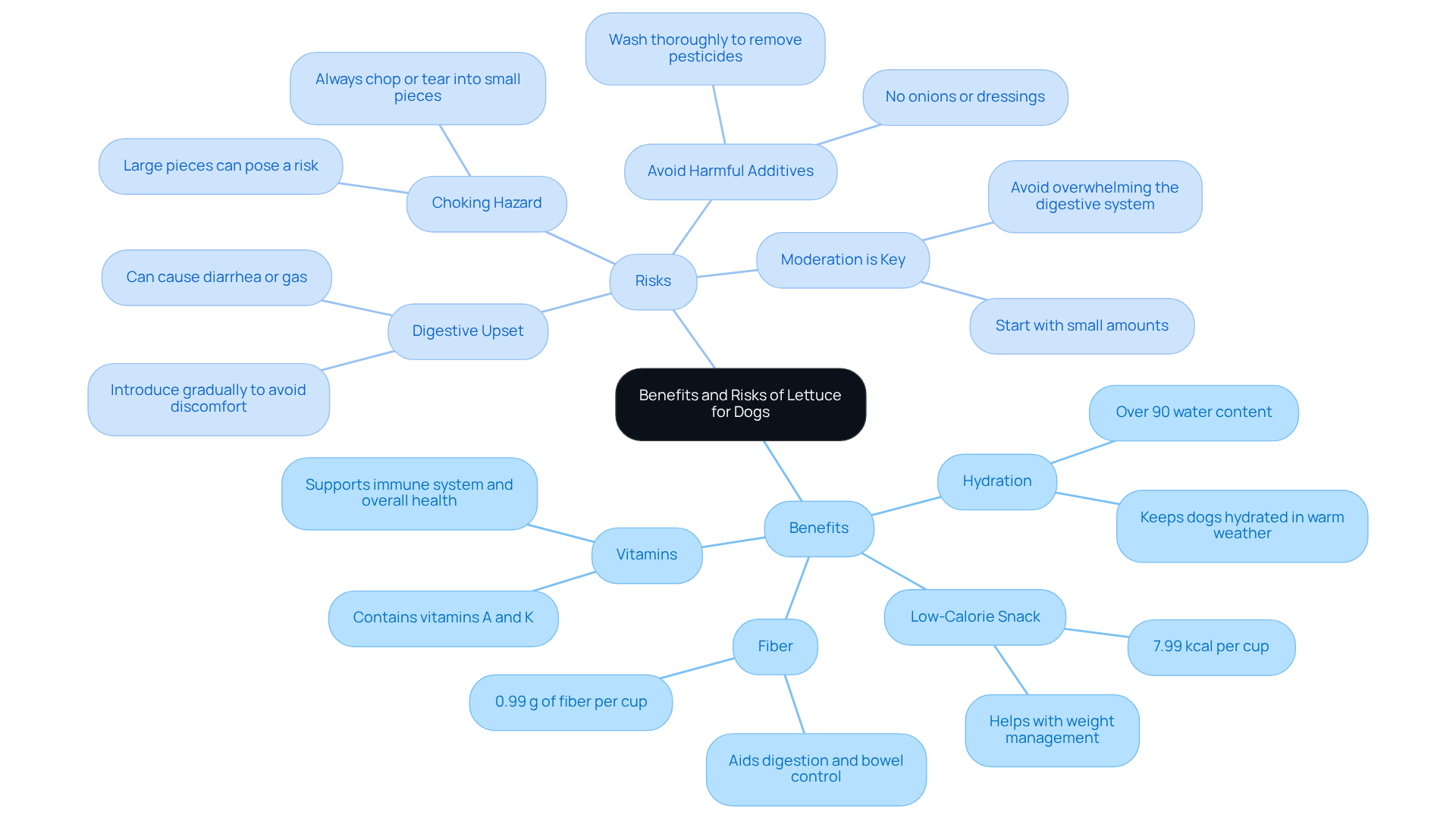
Follow Steps to Safely Introduce Lettuce into Your Dog’s Diet
A wonderful way to enhance your dog’s nutrition is by introducing lettuce into their diet, which leads to the question: can dogs have lettuce? To ensure a safe and enjoyable experience, consider the following steps:
- Choose the Right Type of Lettuce: Opt for dog-friendly varieties like romaine, arugula, or green leaf. These options are low in calories and high in fiber, making them beneficial for your furry family members’ digestion. It’s best to avoid iceberg greens due to their minimal nutritional value.
- Wash Thoroughly: Rinse the greens under running water to eliminate any pesticides or dirt. This simple step can significantly reduce the risk of gastrointestinal upset, ensuring your pet stays happy and healthy.
- Cut into Small Pieces: Chop the greens into bite-sized portions. This precaution is especially important for smaller pets, as it helps prevent choking hazards and makes it easier for them to chew and digest.
- Serve Plain: Offer the greens raw and plain, without any dressings or seasonings that could be harmful. Ingredients like oils or salad dressings may pose risks to your dog’s well-being.
- Start Small: Begin by giving your dog a small piece of leafy vegetable, about the size of a treat. Observe their reaction closely. This gradual introduction is key to preventing any digestive issues that could arise.
- Gradually Increase Amount: If your dog enjoys the lettuce and shows no adverse reactions, you can gradually increase the amount over time. Monitoring their response is crucial to ensure they tolerate this nutritious addition well.
Considering that lettuce is composed of 90 percent water, many wonder if dogs can have lettuce as a hydrating and low-calorie snack that benefits their overall well-being. However, be cautious not to overfeed, as this can lead to diarrhea and upset stomach. By following these thoughtful steps, you can safely include greens in your pet’s diet, nurturing their health and happiness.

Monitor Your Dog’s Reaction to Lettuce
After introducing lettuce into your dog’s diet, it’s essential to closely monitor their behavior and health to determine if can dogs have lettuce.
-
Watch for Digestive Issues: Keep an eye out for signs such as diarrhea, vomiting, or gas. If any of these symptoms arise, consider reducing the amount of lettuce or stopping its introduction altogether, particularly if you’re questioning can dogs have lettuce. Research suggests that gastrointestinal reactions to diets can impact canines of any age or breed, with symptoms frequently emerging following dietary adjustments. It’s important to note that the average age of canines with digestive tract issues is between 6 and 9 years, highlighting the need for vigilance as they age.
-
Monitor Energy Levels: Ensure your dog remains active and happy. A sudden decline in energy levels may suggest an adverse reaction to the new cuisine. Clinical symptoms typically improve within days if the problematic ingredient is identified and removed.
-
Check for Allergic Reactions: While dietary allergies in dogs are relatively uncommon, affecting approximately 10% of dogs, they can occur. Be vigilant for symptoms such as itching, swelling, or excessive scratching. According to veterinarians, signs of dietary intolerance may include diarrhea, vomiting, and lethargy, which can manifest after introducing new items.
-
Consult Your Veterinarian: If you observe any concerning symptoms, it’s crucial to consult your veterinarian for guidance on how to proceed. They can offer customized recommendations based on your dog’s medical background and dietary requirements. Remember, early veterinary care is vital for maintaining your dog’s digestive health, especially if they exhibit signs of distress after trying new foods. As Erin Bortz, a veterinarian, emphasizes, “Keep your pup up to date on all recommended veterinary checkups, vaccinations, and parasite prevention.
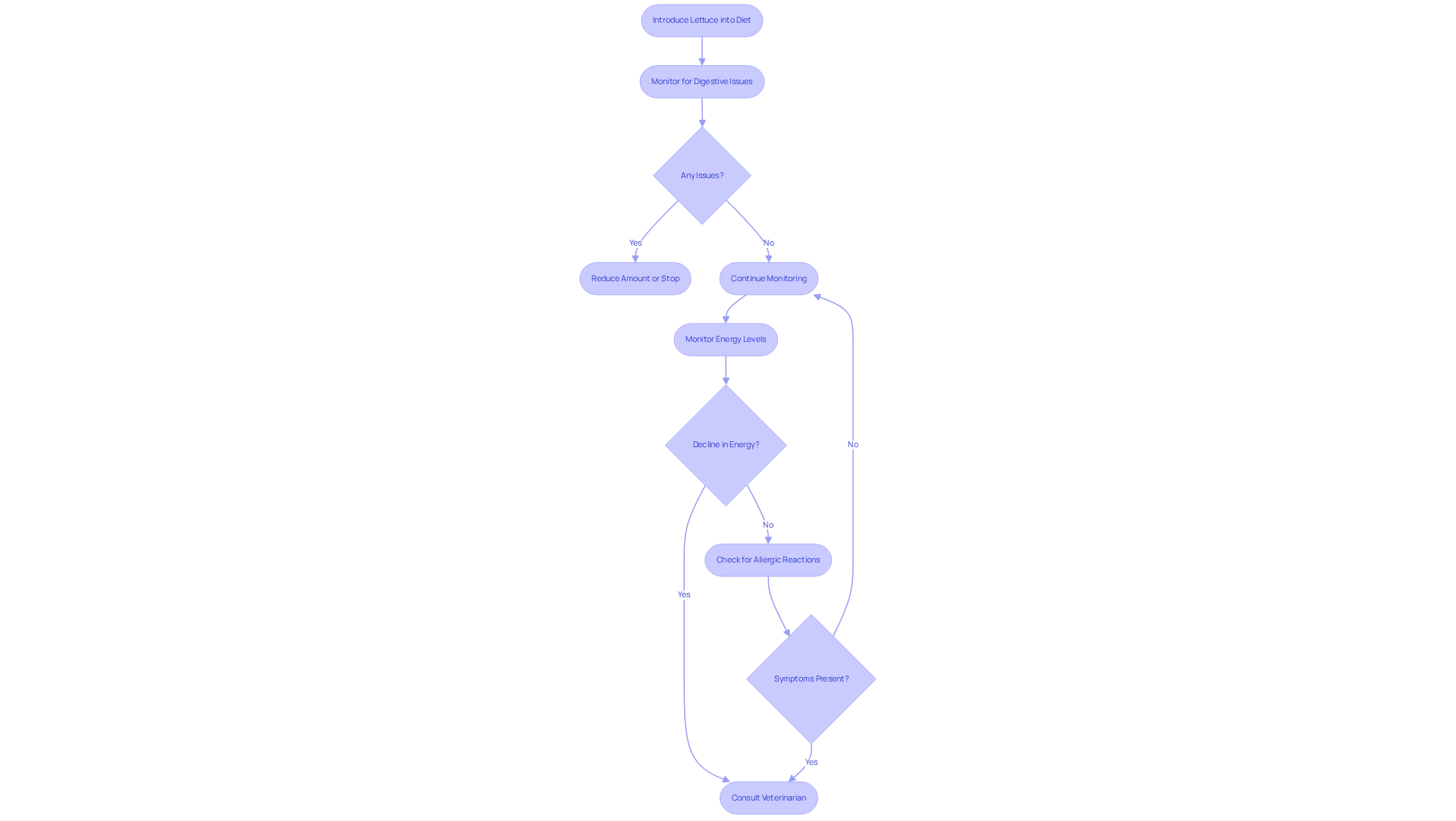
Conclusion
Introducing lettuce into your dog’s diet can be a nutritious and hydrating choice when done thoughtfully. This leafy green offers a low-calorie snack option that can benefit your furry family members, especially those needing to manage their weight. However, it’s essential to approach this addition with care, ensuring it complements their overall nutritional needs rather than replacing vital protein and fat sources.
Understanding your dog’s dietary requirements is crucial. Lettuce provides hydration and fiber, but it’s also important to be aware of potential risks, such as digestive upset and choking hazards. By following these simple steps for safe introduction—
- Selecting appropriate types
- Washing thoroughly
- Cutting into small pieces
- Serving plain
- Starting small
- Monitoring reactions
you can confidently incorporate lettuce into your pet’s meals.
Ultimately, the journey of introducing new foods to your dog should be approached with love and attention. Monitoring their response to lettuce is vital to ensure their well-being. Consulting with a veterinarian can offer tailored advice for your dog’s unique needs. Embracing this gradual approach not only enhances your dog’s diet but also strengthens the bond between you and your pet through shared experiences in exploring new flavors and textures.
Frequently Asked Questions
What are the main components of a balanced diet for dogs?
A balanced diet for dogs includes proteins, fats, carbohydrates, vitamins, and minerals.
Why is protein important in a dog’s diet?
Protein is essential for growth and maintenance, and it’s vital for ensuring that a dog’s primary meals are rich in high-quality protein sources.
What role do fats play in a dog’s nutrition?
Fats are necessary for energy and maintaining healthy skin, so it’s important to include wholesome fat sources in a dog’s regular meals.
How do carbohydrates benefit dogs?
Carbohydrates provide energy and assist with digestion. Lettuce can be a low-calorie carbohydrate option to add variety to a dog’s diet.
What vitamins and minerals are important for a dog’s well-being?
Vitamins and minerals are crucial for overall well-being. While lettuce contains some beneficial vitamins like A and K, it should complement, not replace, other nutrient-dense foods.
Should I consult with a veterinarian about my dog’s diet?
Yes, it is always a good idea to consult with your veterinarian to determine your dog’s specific nutritional needs based on their age, weight, activity level, and health status.



